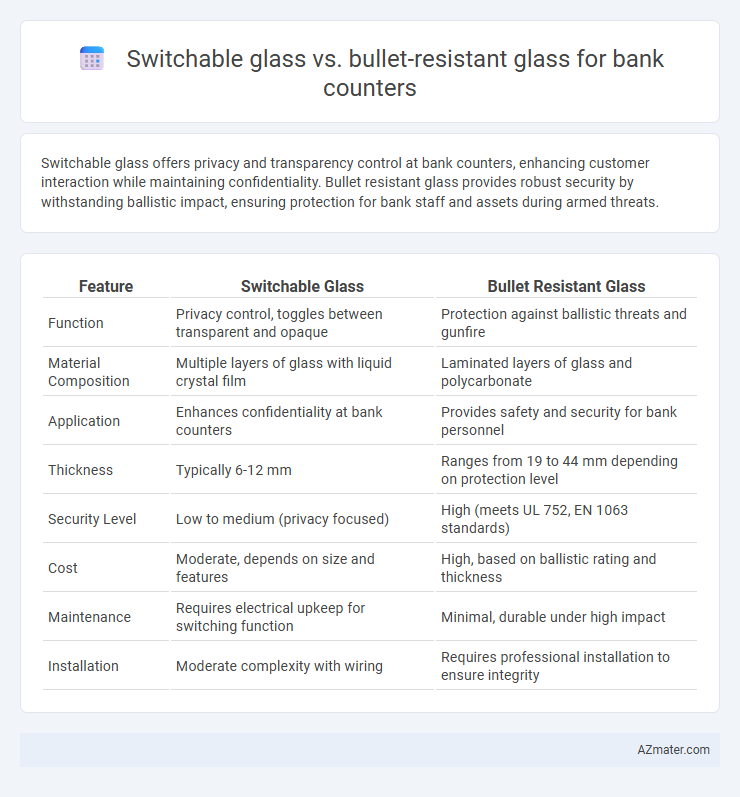Switchable glass offers privacy and transparency control at bank counters, enhancing customer interaction while maintaining confidentiality. Bullet resistant glass provides robust security by withstanding ballistic impact, ensuring protection for bank staff and assets during armed threats.
Table of Comparison
| Feature | Switchable Glass | Bullet Resistant Glass |
|---|---|---|
| Function | Privacy control, toggles between transparent and opaque | Protection against ballistic threats and gunfire |
| Material Composition | Multiple layers of glass with liquid crystal film | Laminated layers of glass and polycarbonate |
| Application | Enhances confidentiality at bank counters | Provides safety and security for bank personnel |
| Thickness | Typically 6-12 mm | Ranges from 19 to 44 mm depending on protection level |
| Security Level | Low to medium (privacy focused) | High (meets UL 752, EN 1063 standards) |
| Cost | Moderate, depends on size and features | High, based on ballistic rating and thickness |
| Maintenance | Requires electrical upkeep for switching function | Minimal, durable under high impact |
| Installation | Moderate complexity with wiring | Requires professional installation to ensure integrity |
Introduction to Glass Technologies in Bank Security
Switchable glass and bullet resistant glass are integral technologies in enhancing bank counter security by addressing privacy and safety concerns. Switchable glass utilizes electrochromic or polymer-dispersed liquid crystal technology to shift from transparent to opaque, allowing instant privacy control, while bullet resistant glass comprises multiple laminated layers designed to absorb and dissipate ballistic energy, preventing penetration. The strategic implementation of these glass types ensures a secure environment, combining advanced privacy features with robust protection against armed threats.
What is Switchable Glass?
Switchable glass, also known as smart glass, uses an electrochromic film to change from opaque to transparent with the flip of a switch, enhancing privacy and security at bank counters. Unlike bullet resistant glass, which is constructed from multiple layers of laminated glass and polycarbonate to stop projectiles, switchable glass focuses on instant visual control without compromising visibility. This technology is ideal for banks requiring both discretion and efficient customer interaction while maintaining a modern aesthetic.
What is Bullet Resistant Glass?
Bullet resistant glass for bank counters is specially engineered to withstand firearm impacts, providing crucial security and protection against armed threats. Made from laminated layers of glass and polycarbonate, it absorbs and disperses the energy from bullets to prevent penetration and keep employees safe. This glass type differs from switchable glass, which primarily controls visibility and privacy rather than offering ballistic protection.
How Switchable Glass Works in Bank Counters
Switchable glass in bank counters employs smart technology by using a layer of liquid crystal film between two glass panels that changes from opaque to transparent when an electric current is applied, offering privacy and security on demand. Unlike bullet resistant glass, which is designed primarily for protection against ballistic threats through layered materials like polycarbonate and tempered glass, switchable glass improves operational efficiency by enabling quick visual privacy without compromising customer interaction. This technology enhances bank counters by allowing staff to control visibility instantly, protecting sensitive transactions while maintaining a sleek, modern aesthetic.
Bullet Resistant Glass: Features and Functionality
Bullet resistant glass for bank counters offers robust protection against ballistic threats, combining multiple layers of laminated glass and polycarbonate to absorb and disperse impact energy effectively. This specialized glass features high resistance to bullets of various calibers, ensuring the safety of bank staff and secure transactions without compromising visibility. Enhanced durability and clear transparency make bullet resistant glass an essential security solution in banking environments where safeguarding against armed attacks is critical.
Security Comparison: Switchable vs Bullet Resistant Glass
Bullet resistant glass provides superior security at bank counters by withstanding high-velocity impacts and preventing firearm penetration, making it essential for safeguarding personnel and assets from armed attacks. Switchable glass, while offering privacy and visibility control through electronic opacity adjustments, does not provide significant ballistic protection or resistance against physical assaults. For security-focused applications like bank counters, bullet resistant glass remains the optimal choice due to its certified strength and impact resistance standards such as UL 752 or EN 1063.
Privacy and Visibility: Pros and Cons
Switchable glass provides instant privacy by transitioning from transparent to opaque, enhancing confidentiality at bank counters while allowing visibility when needed, but it may have reduced durability compared to bullet resistant glass. Bullet resistant glass offers superior protection against physical threats, ensuring security, but maintains constant visibility, potentially compromising privacy. Banks must balance the need for discreet transactions with robust safety measures when choosing between these glazing options.
Installation and Maintenance Demands
Switchable glass for bank counters requires complex electrical installation with wiring for control systems, demanding professional expertise and periodic system checks to ensure functionality. Bullet resistant glass involves heavy, multi-layered panels that need reinforced framing and precise fitting to maintain ballistic protection, resulting in a more labor-intensive installation process with less frequent but specialized maintenance. Maintenance of switchable glass focuses on electronic component upkeep, while bullet resistant glass primarily demands regular inspection for structural integrity and damage repair.
Cost and Longevity Considerations
Switchable glass for bank counters offers moderate initial costs with energy-saving benefits through light control, but may have shorter lifespan due to electronic components requiring maintenance or replacement every 5-7 years. Bullet resistant glass involves higher upfront investment with multilayer laminated materials designed for long-term durability, often exceeding 15-20 years under standard use conditions without significant degradation. Cost-effectiveness between the two depends on balancing the bank's security requirements with maintenance budgets and expected operational lifespan.
Which Glass is Best for Bank Counters?
Switchable glass provides privacy and visibility control at bank counters, enhancing customer interaction while maintaining discretion. Bullet-resistant glass offers superior security by protecting against armed attacks, a crucial feature for high-risk banking environments. For bank counters, bullet-resistant glass is the best choice when prioritizing safety, while switchable glass works well for privacy needs without compromising visual access.

Infographic: Switchable glass vs Bullet resistant glass for Bank counter
 azmater.com
azmater.com